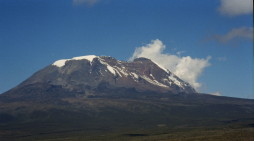
Kilimanjaro is located in northeastern Tanzania near the border with Kenya. Its two volcanic peaks stand about seven miles apart, connected by a broad "saddle." The crater of Kibo, the higher peak, is also covered with an ice cap.
Photo (Travel Explorations): Beautiful Kilimanjaro, the pride of Africa.
What would happen if Mt. Kilimanjaro loses its ice beautiful snow caps? Climate changes would probably be most visible on the top of Mt. Kilimanjaro, but how would the loss of this essential water source impact wildlife and human populations in the Kilimanjaro region? It could be very dramatic effects fear the scientists.
According to the African Wildlife Foundation (AWF - www.awf.org), 25 April 2003, the Kilimanjaro heartland heats up. Whether due to global warming or other causes, recent climate changes could have devastating effects on people, animals and land.
Since 1975, temperatures in Amboseli National Park have been increasing, according to records of AWF collaborators in the Amboseli Baboon Research Project directed by Professor Jeanne Altmann of Princeton University. The daily maximum temperature has jumped 10 degrees over the past 20 years. More troubling, reports Chief Scientist Philip Muruthi, of AWF's Nairobi office, the greatest increases have been in the months that were already the warmest, February and March.
Temperatures in the shade during these months now exceed body temperature for humans and some wildlife, such as monkeys. To make matters worse, due to increased cultivation, overgrazing and land subdivision, over this same period of time the region has lost much of the woodland, trees and shrubs that offer food, shelter and shade for wildlife, and protection for humans and domestic animals.
The transformation of Mt. Kilimanjaro is only the most visible sign of climate changes in AWF's Kilimanjaro Heartland, which includes the semi-arid savannah of the greater Amboseli ecosystem, lying just north and west of the mountain. The Heartland encompasses Amboseli National Park, six large Maasai group ranches, Tanzania's Kilimanjaro and Arusha national parks, as well as Lake Natron and the low-lying savannas of Longido.
In addition to Kilimanjaro it has previous years been extreme weather across the whole African continent. A recent U.N. report documented that farm yields in Lesotho, for example, are down by two-thirds since the 1970s; soil is eroding, and soil fertility is deteriorating. Many scientists would not explain the unusual weather due to global warming, but climate experts believe that the changes are consistent with predictions for a warmer planet. The Intergovernmental Panel on Climate Change says that Africa will be particularly vulnerable to the water and food shortages and diseases expected to be caused by global warming if and when it happens.
Scientists have raised many questions that need to be answered:
- Have local habitat changes caused the climate changes?
- Have the climate changes contributed to the habitat changes?
- And how widespread are these effects?
Wild species are feeling the heat
According to AWF, are plant and animal species around the world are feeling the heat from global warming. But the most dramatic effects may not be experienced for decades, according to Stanford University researchers. "Birds are laying eggs earlier than usual, plants are flowering earlier and mammals are breaking hibernation sooner," the scientists found, according to Nature News Service.
From butterflies to marine invertebrates, the earth's wild species have been shifting their ranges northward as temperatures rise, occupying areas previously too cold for survival. The Stanford study shows that nearly 1,200 species, some 81 percent of the total number analyzed have undergone biological changes that are consistent with our understanding of how temperature change influences wildlife and populations around the world.
Rapid climate change, combined with loss of habitat and other ecological stressors, eventually could lead to the disappearance of species, a consequence that some experts believe might be avoided by taking "proactive" instead of "reactive" conservation measures. Is there something we can do to reverse the development?
Stein Morten Lund, 26 April 2003
Additional information
Read about climbing Kilimanjaro on our website.
You find the ultimate article (in 4 parts) about Kilimanjaro here, and with great photos.
For more information about climate changes in the Kilimanjaro heartland and general information about Africa, enter the African Wildlife Foundation's website
www.awf.org
